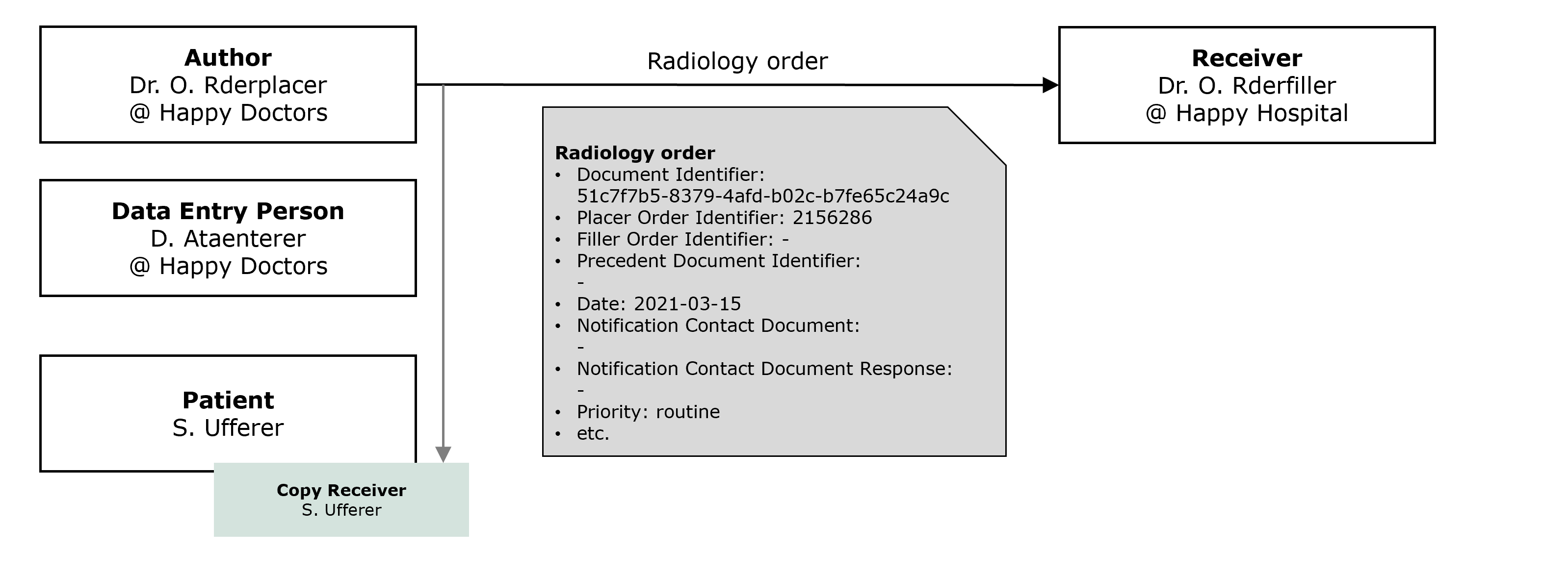CH ORF (R4)
3.0.0-ci-build - ci-build
CH ORF (R4)
3.0.0-ci-build - ci-build
CH ORF (R4), published by HL7 Switzerland. This guide is not an authorized publication; it is the continuous build for version 3.0.0-ci-build built by the FHIR (HL7® FHIR® Standard) CI Build. This version is based on the current content of https://github.com/hl7ch/ch-orf/ and changes regularly. See the Directory of published versions
Mrs. S. Ufferer has an appointment with her general practitioner, Dr. O. Rderplacer, at the Happy Doctors group practice on 15 March 2021. The patient complains of recurrent knee pain. Based on the medical anamnesis and the physical examination, the doctor decides to order an X-ray, which is to be performed at the Institute for Radiology of the Happy Hospital by Dr. O. Rderfiller.
The medical practice assistant D. Ataenterer enters the radiology order and sends it to the Institute of Radiology. The order also indicates that the copy of this order shall be sent to the patient (as well as all results therefrom).

Mrs. S. Ufferer feels a stabbing pain in her lower abdomen in the late evening of 30 March 2021. Her general practitioner at the Happy Doctors group practice, who is on emergency duty, refers the patient to the Regional Hospital.
The doctor on duty at the Regional Hospital, Dr. P. Lacer, orders a thorax CT. Based on the thorax CT, he suspects an aortic aneurysm. As there is no radiologist on duty at the Regional Hospital during this night shift, Dr. P. Lacer telephones the radiologist Dr. F. Iller at the University Hospital and sends her the order for the external diagnostics. Because of the suspected diagnosis, time is pressing and the radiologist wants to be contacted urgently after receiving the order with the CT images.
The suspicion of an aortic aneurysm is confirmed and Dr. F. Iller immediately reports this by telephone to Dr. P. Lacer. Mrs. S. Ufferer is therefore moved to the thoracic surgery unit as an emergency and is operated on immediately.

An application for home care (or also another outpatient service, e.g. meal service) can be made in different situations:
Patient is at home
Patient is currently in an inpatient facility and will be discharged home soon.
Patient is at home, but will enter an inpatient facility (e.g. hospital) and will be discharged from this (or a subsequent inpatient stay (e.g. rehab) to home.
In the case of an inpatient stay before home care, the discharge date and possibly also the entry date are important for planning home care; the institution of the inpatient stay should also be known for necessary inquiries.
The application for home care is often made on the initiative of a third party. It is important to know whether the initiator is the legal representative.
The registration for home care is often - especially in the case of inpatients - not initiated by the family doctor; however, the family doctor must be known to the home care.
In practice, a (provisional) registration for home care may be necessary before the patient's formal consent has been obtained. This must be stated in the registration
The above information is of an administrative nature; CH ORF provides with version 1.1. appropriate attributes. Regarding the patient's consent, the form allows a differentiated representation of the situation as free text.
For the entry of further medical and nursing information, please refer to CH eTOC.
The additional information for the application for home care (see above) also covers the administrative requirements for discharge letters. In addition, further medical and nursing information is required for this use case. For this, please refer to CH eTOC.
For various reasons, scheduling appointments is tricky:
It is not easy to cover all these contingencies with a simple application. Therefore, comprehensive scheduling of appointments for referrals is out of scope in this implementation guide. However, it is possible to specify the date and time and to note whether the appointment is firmly agreed or merely proposed. Furthermore, it is possible to indicate preferred date/time intervals.
Some service providers offer their services at more than one location, so it can also happen that one assignment/prescription leads to more than one consultation (e.g. Holter ECG with an appointment for installation of the device at the beginning and an appointment for return at the end). In CH ORF, therefore, several appointments (n Appointments) are provided per service order (ServiceRequest).